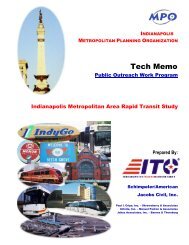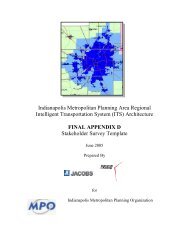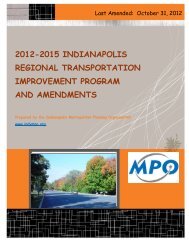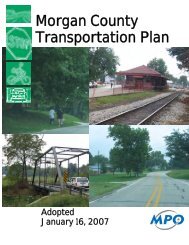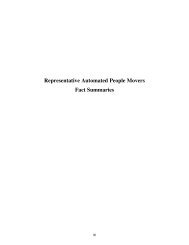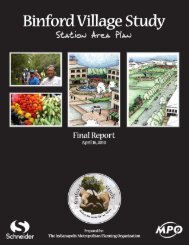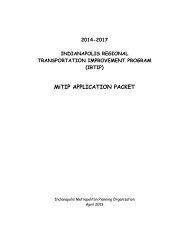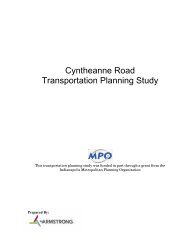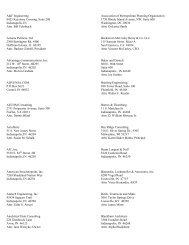MPO Policy and Procedures Manual - Indianapolis Metropolitan ...
MPO Policy and Procedures Manual - Indianapolis Metropolitan ...
MPO Policy and Procedures Manual - Indianapolis Metropolitan ...
Create successful ePaper yourself
Turn your PDF publications into a flip-book with our unique Google optimized e-Paper software.
Data<br />
The primary data source for demographic data in the United States for over 60 years has been<br />
the U.S. Decennial Census of the Population. This Census, performed by the U.S. Bureau of<br />
the Census was last conducted in 2000 <strong>and</strong> contained two parts that year. The first part, called<br />
the Short Form, was a 100% sample that provided population, household <strong>and</strong> voting data. The<br />
Long Form, a sample of one in every six to eight households, provided detailed social,<br />
economic <strong>and</strong> demographic information. Because of the sample size of the Long Form, this<br />
detailed data set was available for small geographic areas.<br />
In 2003, the Census Bureau initiated a new, annual survey called the American Community<br />
Survey (ACS), to take the place of the detailed Long Form, beginning in 2010. The sample size<br />
of the ACS is approximately one in every thirty-two households. Valid statistics for small area<br />
statistics produced by the ACS are published as 5-year moving averages. The ACS began data<br />
collection in 2005-2006 <strong>and</strong> its first 5-year estimates are due in 2010-11.<br />
The <strong>MPO</strong> uses a special aggregation of Census data called the Census Transportation<br />
Planning Package (CTPP), purchased on behalf of the transportation community by ASHTO<br />
(the American Association of State of Highway Transportation Officials). The CTPP is<br />
being modified to accommodate the change from the Census Long Form to the ACS. The <strong>MPO</strong><br />
also uses demographic data prepared by Nielsen-Claritas.<br />
Economic data are garnered from a variety of sources. The <strong>MPO</strong> leases data from the D&B<br />
Selectory data base <strong>and</strong> has acquired data from both the Indiana Secretary of State’s Business<br />
Licensing data base <strong>and</strong> the Indiana Department of Workforce Development’s ES-202 data<br />
base.<br />
The <strong>MPO</strong> uses forecasts of economic <strong>and</strong> population values produced by both the State of<br />
Indiana <strong>and</strong> Woods <strong>and</strong> Poole. These data are largely used as county- or township- level<br />
control totals. These control totals are allocated to smaller geographic areas using a type of<br />
l<strong>and</strong>-use allocation model.<br />
During 2008 <strong>and</strong> 2009, the <strong>MPO</strong> has conducted two significant travel data studies. The Central<br />
Indiana Travel Survey (CITS) <strong>and</strong> the IndyGo On-Board Survey. The CITS collected data for up<br />
to 4000 household upon its completion in December of 2009. The IndyGo On-Board Survey<br />
collected data on over 4000 bus riders. Data from these two surveys will be used extensively in<br />
updating the <strong>MPO</strong>’s travel dem<strong>and</strong> model in 2010.<br />
Transportation network data are garnered from a variety of sources, including the Indiana<br />
Department of Transportation (INDOT), different local engineering departments, <strong>and</strong> original<br />
data collection (both field <strong>and</strong> from aerial photography). Types of network data currently<br />
collected include traffic counts, centerline locations, lane widths, facility types, <strong>and</strong> posted<br />
speeds. During 2009, the <strong>MPO</strong> began full-time collection of traffic counts, finishing the third year<br />
of a three-year system traffic count cycle.<br />
Travel Dem<strong>and</strong> Model <strong>Procedures</strong><br />
The travel dem<strong>and</strong> model is a tool for estimating network volumes (vehicles per hour) <strong>and</strong><br />
speeds (miles per hour) thereby enabling the derivation of vehicle miles of travel (VMT) <strong>and</strong><br />
52



